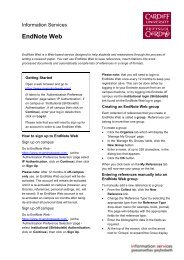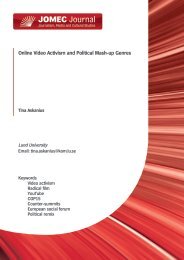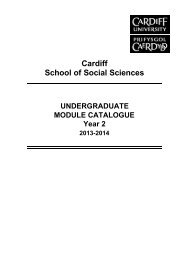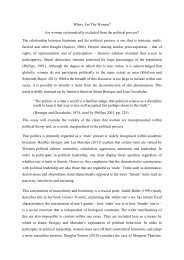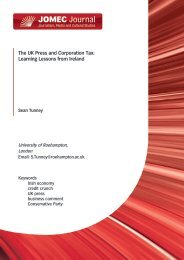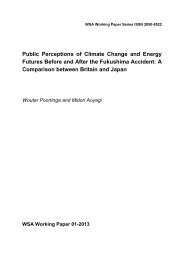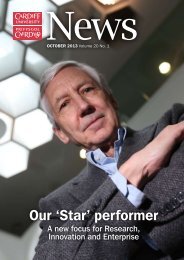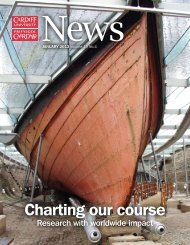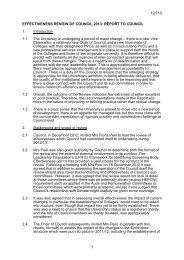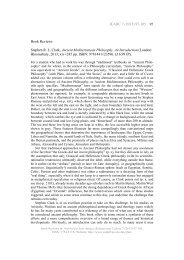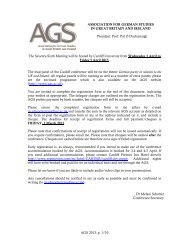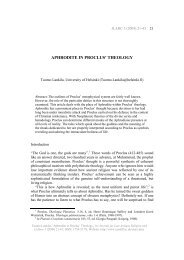pdf format - Cardiff University
pdf format - Cardiff University
pdf format - Cardiff University
Create successful ePaper yourself
Turn your PDF publications into a flip-book with our unique Google optimized e-Paper software.
© B Adam – web complexity futures - 230905 1<br />
Futurity from a Complexity Perspective<br />
© Barbara Adam<br />
Abstract<br />
On first inspection of complexity theory one expects there to be an affinity with a temporal<br />
perspective on social relations and institutions. Many of its key concepts have a decidedly<br />
temporal ring to them, with ‘emergent properties’, ‘non-linear dynamics’, ‘interactive flows<br />
of exchange’ just some of the more pertinent examples. Equally, the idea of feedback-loops<br />
resonates not only with reflexivity in social theory but also with the social enfolding of past,<br />
present and future. On the surface, therefore, complexity theory is time friendly and amenable<br />
to take account of purposive and constitutive processes of interaction. On closer inspection,<br />
however, the application of complexity theory to human socio-temporal relations in general<br />
and the production of futures in particular turns out to be more problematic than it first<br />
appeared. In the last chapter of Timewatch (1995) I have set out my detailed position on social<br />
complexity from a temporal perspective. In this working paper I start from a complexity<br />
perspective and then ask how well it is equipped to encompass futurity within its cohesive<br />
web of key assumptions, and whether the social future might be a complexity too far.<br />
Bringing together complexity theory with a focus on the future raises questions about the kind<br />
of complexity that emerges when we take social futurity seriously. From this, in turn, arise<br />
questions about implications for social science research.<br />
Biographical Details<br />
Barbara Adam is Professor of Sociology at <strong>Cardiff</strong> <strong>University</strong>. She is founding editor of the<br />
journal Time & Society and has published extensively on the social relations of time. Her<br />
most recent book Time (2004) is published under the Polity Press ‘Key Concepts’ Series. She<br />
currently holds an ESRC Professorial Fellowship in which she explores the social relationship<br />
to the future. web sites: http://www.cf.ac.uk/socsi/whoswho/adam/<br />
http://www.cf.ac.uk/socsi/futures/<br />
Acknowledgement<br />
The research has been conducted during a three-year research project 'In Pursuit of the<br />
Future', which is funded by the UK’s Economic and Science Research Council (ESRC) under<br />
their Professorial Fellowship Scheme.
© B Adam – web complexity futures - 230905 2<br />
Complexity Theory for the Social sciences<br />
For the social sciences, complexity theory is a welcome change. Its root in mathematical and<br />
natural science perspectives gives it respectability. As socially revered ‘scientific’ (meaning<br />
‘hard’ science) knowledge, it can support and give credence to the more complex analyses of<br />
the social world. In other words, when the natural sciences and mathematics ‘discover’<br />
complexity, their ‘findings’ legitimate what have been inescapable features of cultural<br />
investigation and knowledge. To accommodate the public reverence for knowledge based on<br />
‘scientific evidence’, the socio-cultural sciences have had to squeeze the complexity of their<br />
living, creative, productive, innovative, questing, temporally extended, future oriented,<br />
knowledge based, reflexive, moral subject matter into a methodology designed for inanimate<br />
matter (dead things) in motion. To be recognised as a scientific enterprise they had to find<br />
ways to square the circle of social complexity and scientific reduction to simplicity and<br />
general laws.<br />
Complexity perspective, as it is applied to biological systems, allows for bringing into a<br />
coherent unity of analysis the material, spatial and temporal dimensions of existence. Material<br />
structure, spatial patterns of networked relations and temporal processes of becoming are<br />
given equal weight in the analysis. The material, spatial and temporal are seen as mutually<br />
implicating rather than mutually exclusive. For the social sciences this is a methodological<br />
quantum leap that takes scientific praxis out of the dark ages of binary opposites,<br />
reductionism and linear causality and reunites what had been so carefully prised apart. More<br />
revolutionary still, the temporal is given due recognition, with many of the key concepts of<br />
complexity theory having a decidedly temporal ring to them: ‘attractors’, ‘autopoiesis’,<br />
‘catalysis’, ‘co-evolution’, ‘emergent properties’, ‘dissipative structures’, ‘feedback loops’,<br />
‘interactive flows of exchange’, ‘iteration’, ‘non-linear dynamics’, ‘perturbation’ and<br />
‘synergy’ being just some of the more pertinent examples. When material structure, spatially<br />
networked relations and temporal processes are brought together in one analytical framework,<br />
context becomes an important consideration. It brings with it an implicit appreciation that<br />
each approach to investigations will need to be appropriate to its subject matter, that is, the<br />
knowledge sphere to which research and analysis are directed. Single cell or ganisms will<br />
require different conceptual and methodological tools from earthworms, forests different ones<br />
from social organisations and institutions. No one method will fit all. Once more, the<br />
complexity framework of analysis provides the social sciences with tremendous potential for<br />
scope and development.<br />
This much-appreciated increased scope, however, comes at a price. The complexity<br />
perspective increases uncertainty. It asks us to embrace it, to face up to it, to find new ways to<br />
engage with it. That is discomfiting and disconcerting stuff. Focus on complexity may be<br />
essential to better understand and cope with the contemporary world of our making but it<br />
leaves us more vulnerable and discomforted. It unsettles tried and trusted schemas of coping<br />
with the unknown. Thus, when politicians and funding bodies, for example, continue to<br />
hanker after the science of old and expect certainty, simplicity, and trustworthy evidence, they<br />
resist the loss of certainty that comes with a complexity perspective on the social world and<br />
the changes it introduces to the way the future has been handled for the past three hundred<br />
years. They want to retain the historically tempered deep structure of cultural engagement<br />
with the not yet and the unknown.<br />
Questions we need to ask in the context of this futures research project is whether the<br />
complexity perspective with its key components is adequate to the study and explanation of<br />
temporally extended human culture or whether socio-cultural futurity is a complexity too far.
© B Adam – web complexity futures - 230905 3<br />
Complexity of Social Futurity<br />
Extension into the future is a defining characteristic of human culture (see figure 1). Futurity<br />
as primary orientation is an emergent property in the chain of being that marks us as humans.<br />
Archaeological records of earliest forms of humans show that they extended their influence<br />
beyond the present sphere of action and ventured into the realm of the ‘not yet’. By<br />
establishing a relationship to death the biological boundaries of individual lives were opened<br />
up and made flexible; individual finitude was transcended by cultural means. From historical<br />
records we know that throughout the ages experts were consulted to prophesise the future and<br />
forecast individual and collective fates. The quest to render the uncertain more certain has<br />
spawned industries and technologies. Scientific predictions, trend analyses, forecasts and<br />
foresight exercises are merely the latest in a very long history of efforts to cope with the not<br />
yet, know the unknowable and make the opaque transparent.<br />
Attempts to know the future were complemented by development of know-how, knowledge<br />
practices intended for access to the beyond by both the living and the dead. Shamanism,<br />
clairvoyance, astrology, séance, death rituals, Aboriginal dreaming and tattooing being just<br />
some examples. With artefacts, cultural permanence is inserted into the world of directional<br />
change and cyclical renewal. Some of this artefactual continuity outlasts its creators into the<br />
long-term future, whether the cultural products are burial chambers, temples or cathedrals,<br />
paintings, novels or musical instruments, cities or institutions, radiation from nuclear<br />
technology or chemical pollution. Some are means to colonise the future; others have the<br />
potential to eliminate the future: our own and that of successors. Much of scientific and<br />
technological development is to aid social efforts to gain control over this elusive realm<br />
beyond control. As long as the changes introduced are small and incremental, a certain<br />
measure of control is possible. The more substantial the cultural insertion, the greater the<br />
scale and the higher the speed of the change, however, the higher will be the resulting level of<br />
complexity, the larger are going to be the unintended consequences and the smaller is the<br />
potential for predictability and control.<br />
When we look more closely at futurity we recognise that different combinations of past,<br />
present and future afford different subject positions on the one hand and different action<br />
potentials on the other. The sample below is in no way intended to be exhaustive but merely<br />
indicative of some of the different kinds of futurity that arise from the modulations with their<br />
associated subject positions and action potential.<br />
Futures: open & contingent sphere of choice, option, imagination, rational action, projection<br />
The Future: realm of projections, predictions, foresight, trend analyses, utopia, expectation<br />
Past Futures: beyond influence, record of potential hopes, fears & choices, memory of future<br />
Future Pasts: mind world of imagination, vision, projection, speculation, potential memories<br />
Future Futures: world of science fiction, futurology, scenarios, hopes, dreams and visions<br />
Present Future: realm of economic activity, empirical study, instrumentality, politics/policy<br />
Present Futures: ‘possidictions’, choice, selection, option, instrumentality, deeds underway<br />
Future Presents: immanent/latent/invisible process realm of (techno-scientific) productions<br />
Past Futures in Present: predecessors’ hopes/desires/decisions/actions as contexts for plans<br />
Past Futures in the Future: potential reduced to activated choices not yet symptom or cause<br />
Pasts & Futures in the Present: present action delimited by past and/or future based action<br />
Past Futures extending into Future: predecessors’ futures delimiting our context of action<br />
With the complexity of cultural futurity in mind, we can appreciate that it may be exceedingly<br />
difficult, if not impossible to encompass the human social with complexity theory’s triple<br />
base of analysis – material structure, patterned relations and process. In his Hidden<br />
Connections Fritjof Capra adapts and extends the triple schema for analyses of the human<br />
social world. He changes the elementary units to matter, form and process in order to<br />
accommodate the social sciences’ different use of structure and pattern and he adds a fourth<br />
dimension of ‘meaning’ to account for the evolutionary emergent property of the social, that
© B Adam – web complexity futures - 230905 4<br />
humans act in the light of knowledge and social investigators interpret a pre-interpreted<br />
world. With the fourth dimension of meaning added to encompass the increased complexity<br />
that arises with self-reflective consciousness and socially constituted knowledge, we are ready<br />
to explore what might be involved when the social is viewed from a complexity perspective.<br />
• Matter is our physical world: the earth we live on, the soil that feeds us, the air we<br />
breathe, the water we depend on, the body we inhabit, the landscapes and cityscapes we<br />
dwell in, the other beings we co-evolved and co-exist with and the world of artefacts we<br />
created. It thus includes our socio-culturally produced world, such as buildings, clothes,<br />
books, tools, machines, vehicles, power stations, instruments, computers, laboratory<br />
products such as plastics, viruses and genetically modified organisms, etc.<br />
• Form encompasses patterned and networked relations of family and friends, work and<br />
play, with domesticated and non-domesticated other species. It covers all infrastructural<br />
aspects of social life such as institutions and communication systems (including<br />
transport), as well as political, economic, religious and knowledge-based associations.<br />
• Process focuses on the temporal aspects of the world of matter and relations. It relates to<br />
the way this world is produced and to emergent properties arising from interactions. As<br />
such it includes understanding of the dynamics of change and creativity, continuity and<br />
discontinuity, stability and novelty, cycles of repetition, evolution and history.<br />
• Meaning involves products and processes of reflective consciousness and socially<br />
constituted knowledge such as language, values and beliefs, what Karl Popper (1983)<br />
calls the world of ‘intelligibles’. With meaning we acknowledge that humans interpret a<br />
pre-interpreted world, that they inescapably operate in a context of double hermeneutics.<br />
To bring these four elements together in social analyses is clearly a vast improvement on the<br />
either-or thinking that governed the perspectives of old: either structure or process, function<br />
or meaning, order or control, system/institution or individual action, technology or language,<br />
mind or matter and other combinations of these and further incompatibles. As a coherent<br />
framework, which does not privilege one element over any of the others, the complexity<br />
perspective encourages an understanding that appreciates the embodied, embedded, nested<br />
and contextual nature of social relations and processes. It facilitates understanding of the<br />
hidden connections and the interdependence of everything with everything.<br />
To theorise this complexity and make it intelligible is a more difficult endeavour than appears<br />
at first sight. Since we can’t hold all the balls in the air all the time, I have in the past<br />
suggested that we need to work with the idea of implication. I had proposed (Adam 1990,<br />
1995) that aspects of our socio-cultural complexity, which are not primarily focused on or<br />
fore-grounded in any given investigation (be this theoretical or empirical), nevertheless have<br />
to be implicated in the understanding and the analysis. This means knowing our world<br />
holographically, where the disattended is enfolded in that which is attended to and where the<br />
explicated implicates that which is out of focus. I still hold to this view, and maintain that it is<br />
one way to encompass complexity not just as rhetoric but social science praxis. It makes for<br />
difficult writing of theory, given that writing is a serial medium. It gets more difficult still<br />
when the approach is used in empirical research. The struggle is well worth the effort,<br />
however, as the work of David Byrne (1998) shows, and should not deter us from the pursuit<br />
of complexity in our research and our endeavours to communicate it accessibly.<br />
From the above you can see that I am in full support of this way of looking, framing and<br />
understanding the human social. There are, however, issues that still trouble me, which I feel<br />
need further attention. I am referring here to three problematiques in particular:<br />
• the strong present-orientation of the approach, which cannot easily encompass the<br />
temporal extension and futurity of socio-cultural life,<br />
• the way we conceive of causality<br />
• and the bracketing of responsibility.<br />
It is these, which I briefly want to address in the last section of this paper.
© B Adam – web complexity futures - 230905 5<br />
Taking Complexity Seriously: Implications for Social Science Research<br />
Bringing the four elements of social complexity together as coherent framework of analysis<br />
changes each of the single elements. Understood as a complex whole, the units implicate each<br />
other, each element resonating with all others, the quality of each changed in the process. In<br />
this presentation I cannot outline all of these changes. Instead I will just indicate how matter,<br />
form and meaning are changed by the requirement to encompass process as an integral part of<br />
the complexity framework of analysis. In addition, with figure 2, I provide one example of the<br />
mutual implication of Form, Process and Matter without yet assigning it to any particular<br />
context of investigation. Thus, when we allow for the temporal to be implicated in the<br />
structural elements of social complexity our understanding of the ‘nature’ of the elements<br />
needs to change:<br />
• Matter needs to be understood not just spatially as frozen in time but also as temporally<br />
extended and enduring, decaying and regenerating, leaving a record, projecting into the<br />
future and entailing for-ness.<br />
• Form needs to be conceived not only synchronically as pattern and structure but also<br />
diachronically: form as forming (figure 2), relations as relating, networks as networking,<br />
patterns as patterning.<br />
• Processes, in turn, need to be grasped not merely as the dynamic that produces the<br />
emergent present but more importantly as processes that produce timescapes 1 and<br />
futurescapes, where much of the on-goings are time-space distantiated and therefore often<br />
latent, immanent and invisible until, that is, where processes congeal into matter and<br />
emerge as symptom – sometime, somewhere.<br />
• Meaning, interpretation, values and beliefs, which tend to be tied to the present or the a-<br />
temporal (Platonic) realm of ideas, need to be temporalised, to resonate with process and<br />
becoming, with form as forming, historical and projective.<br />
In order to accommodate the active, processual quality of meaning, I would like to propose<br />
that we change the domain of ‘meaning’ to that of ‘knowledge practices’. With this change of<br />
label, the subject matter of the overarching fourth dimension remains in tact whilst the new<br />
focus allows for a more active nature of knowledge. It sets knowledge in motion, shows the<br />
productive nature of knowledge as practice, that is, its processuality and its temporal<br />
extension. With the knowledge sphere infused with contextual, projective practice, the<br />
persistent space- and present-bound imaginary of old, which continues to underpin and<br />
pervade contemporary approaches to comple xity, is overcome and the conceptual ground<br />
prepared for timescapes and futurescapes to be encompassed.<br />
A similar situation pertains with respect to causality. The complexity perspective requires<br />
non-linear thinking, that is, to understand networked interdependencies and processes in a<br />
reflexive, autopoietic, non-sequential, non-linear way. When we look more closely at the<br />
implicit understanding of causality that underpins much of the writing on complexity,<br />
however, we see that the meaning of causality has not been adapted to the requirements of the<br />
complexity perspective. Even Fritjof Capra (2003), one of the most consistent complexity<br />
thinkers to date, tries to retain the traditional scientific meaning of causality. I would like us<br />
to reconsider this position and re-visit Aristotle’s proposal to understand causality with<br />
reference to four interdependent elements. It is my argument that these four mutually<br />
implicating elements are essential to the quadruple complexity proposed for the social realm,<br />
which they parallel to perfection:<br />
1 (Adam 1998 and 2004 for detailed elaboration)
© B Adam – web complexity futures - 230905 6<br />
Aristotle’s causes:<br />
Material cause<br />
Formal cause<br />
Effective cause<br />
Final cause<br />
Complexity dimensions:<br />
Matter<br />
Form<br />
Process<br />
Knowledge practices, temporally extended<br />
and future oriented<br />
The history of the way causality has been conceived shows that the natural sciences have<br />
reduced the first three causes to one general physical cause where action causes subsequent<br />
effects in a linear fashion from past to present and future 2 . The idea of a ‘final cause’ as both<br />
for-ness and the goal or end towards which organisms develop has been eliminated altogether.<br />
Biological scientists, however, had difficulty with the eradication of final causes, given that<br />
they were encountering unmistakable forms of goal directedness in their subject matter.<br />
Acorns grow into oak trees (and not beech trees or dandelions), the final cause of the oak tree<br />
being encoded in the acorn, and vice versa. To eliminate all traces of the religious language of<br />
creation and destiny, biological scientists replaced final causes with the a-temporal idea of<br />
function: each part has a function within the whole. Thus, the function of a part brings about<br />
development, not its potential encoded in a pre-existing end. It is the acorn’s function not its<br />
destiny to become an oak tree. With this simple move the temporal has been reigned in and<br />
futurity effectively shielded out from scientific causality. In its place, the past and the a-<br />
temporal present have been installed as the exclusive sources of scientific meaning. Soc ial<br />
theorists will recognise the parallel move in the social sciences.<br />
The complexity perspective on the social provides us with the means and motivation to<br />
overcome that reductionist, linear, a-temporal understanding and take account instead of the<br />
complex, interdependent, temporally extended social realm of matter, relations, processes and<br />
knowledge practices that produce time-space distantiated material effects. It is because our<br />
knowledge practices have impacts, which extend both spatially and temporally, that we need<br />
to explore ways that allow us to accompany the consequences to their eventual, potential<br />
destinies: tomorrow, in one hundred, even one thousand years’ time. For this we need a causal<br />
understanding that transcends the Newtonian perspective. This new complexity<br />
conceptualisation of causality needs to achieve the following:<br />
• implicate each of the other dimensions in any one aspect explicated<br />
• extend not just from the past to present and future but also from the future to the present<br />
and the past<br />
• allow for the future-to-present direction to be not just an aspect of mind, that is of our<br />
imagination, but to be materially constituted as for-ness and as deeds under way, as<br />
futures in the making that cast shadows from the future to the present, not yet congealed<br />
into matter but material nevertheless.<br />
We may not want to call this fourth cause ‘final cause’. We may find a better match to the<br />
meaning/knowledge practice elements of the complexity perspective on the social.<br />
Irrespective of the label we might want to attach to it, however, the pertinence of Aristotle’s<br />
‘final cause’ relates to its materiality, that final causes permeate the realm of matter. In<br />
contradistinction to Capra (2003: 65), I want to argue that for today’s social sciences that seek<br />
to take complexity seriously, this is precisely the point: future-oriented and future-creating<br />
knowledge practices have material effects that reverberate through the entire system of<br />
2 It is important to bear in mind here that the concept of cause as established by the empiricist David<br />
Hume and modern science cannot be mapped cleanly onto Aristotle’s concept of aition, an inherently<br />
ambiguous term which means whatever one can cite in answer to a “why?” question. Aristotle<br />
recognised that explanations for the emergence of a phenomenon can be given from various<br />
perspectives. Of these, only that of effective or efficient causality comes close to the modern scientific<br />
notion of cause. Aristotle’s concept of explanation is therefore much wider than that of cause, and<br />
rules out the possibility of completely understanding a phenomenon by explaining it deterministically<br />
and reductively in relation to previously existing states of the system to which it belongs.
© B Adam – web complexity futures - 230905 7<br />
physical, biological and cultural relations and processes. Aristotle’s four causes, therefore,<br />
provide us with a base from which to start our reconceptualisation of causality in a way that is<br />
consistent with the complexity perspective.<br />
This brings me neatly to the issue of responsibility, the last point I wanted to address with<br />
regard to implications for social science approaches that seek to take complexity seriously.<br />
When we understand the social as embedded in and interdependent with the entirety of our<br />
world and when we grasp that our knowledge practices are neither isolated nor isolatable<br />
from their networked connections, that our actions reverberate through the system, activating<br />
responses that are not necessarily proportional to their initial ‘cause’, then we are also bound<br />
to recognise that we are implicated participants that cannot escape their responsibility. The<br />
complexity perspective deprives us of the comfortable position of external, uninvolved<br />
observer. It divests us of the ‘view from nowhere’ that allowed us to act with impunity. This<br />
change in understanding of our subject matter brings with it a change in methodology and<br />
both in turn confront us with our constitutive knowledge. The complexity perspective<br />
therefore demands that we acknowledge ourselves as future makers and understand our<br />
responsibilities accordingly.<br />
At the end of this exploration, do we think that futurity is a complexity too far for social<br />
science research? My answer is: not necessarily. It is merely an exceedingly complex task that<br />
requires our collective determination and effort to take seriously our responsibility as social<br />
scientists, citizens and participating members of a complex world.<br />
*****<br />
Bibliography<br />
Adam, B. 1990 Time and Social Theory. Cambridge: Polity Press.<br />
Adam, B. 1995 Timewatch: The Social Analysis of Time. Cambridge: Polity Press.<br />
Adam, B. 1998 Timescapes of Modernity. The Environment and Invisible Hazards. London &<br />
New York: Routledge.<br />
Adam, B. 2004 Time. Cambridge, UK & Malden, MA: Polity<br />
Bohm, D. 1983 Wholeness and the Implicate Order. London: ARK<br />
Briggs, J. and Peat, D. 1989 Turbulent Mirror. New York: Harper and Row.<br />
Byrne, D. 1998 Complexity Theory and the Social Sciences. New York/London: Routledge.<br />
Capra, F. 1996 The Web of Life. New York: Anchor/Doubleday.<br />
Capra, F. 2003 The Hidden Connections. London: Flamingo.<br />
Dawe, A. 1970 ‘The Two Sociologies’ British Journal of Sociology, 21: 207-18,<br />
Giddens, A. 1979 Central Problems in Social Theory. Action, Structure and Contradiction in<br />
Social Analysis. London: Macmillan Press.<br />
Hayles, K. N. 1990 Chaos Bound. Orderly Disorder in Contemporary Literature and Science.<br />
Ithaca: Cornell UP.<br />
Jonas, H. 1984/1979 The Imperative of Responsibility. In Search of an Ethics for the<br />
Technological Age, Chicago: <strong>University</strong> of Chicago Press.<br />
Jouvenel, B. de 1967 The Art of Conjecture, transl. from French by N. Lary, London:<br />
Weidenfeld and Nicolson.<br />
Luhmann, N. 1982 The Differentiation of Society. New York: Columbia <strong>University</strong>.<br />
Nowotny, H. 2001 Coping with Complexity. On Emergent Interfaces between the Natural<br />
Sciences, Humanities and Social Sciences. Ms.<br />
Popper, K. 1972/1983 Objective Knowledge. An Evolutionary Approach. Oxford: Oxford UP.<br />
Prigogine, I. and Stengers, I. 1984 Order out of Chaos. London: Heinemann.<br />
Thrift, N. 1999 ‘The Place of Complexity’. Theory, Culture & Society, 16/3: 31-70.<br />
Urry, J. 2003 Global Complexity. Cambridge: Polity.<br />
Wynne, B. 2005 ‘Reflexing Complexity: Post-Genomic Knowledge and Reductionist Returns<br />
in Public Science. Theory, Culture and Society 22: 67-94.<br />
Zohar, D. and Marshall, I. 1993 The Quantum Society. London: Bloomsbury.
© B Adam – web complexity futures - 230905 8<br />
Figure 1<br />
Futures 3<br />
We tell futures<br />
Druids & wizards<br />
Oracles & prophets<br />
Astrologers & palmists<br />
Scientists and soothsayers<br />
All but different means & modes<br />
We know futures<br />
From past experiences<br />
Forecasts & forebodings<br />
By prevision & premonitions<br />
Through clairvoyance & intuition<br />
To indeterminate degrees of certainty<br />
We create futures<br />
Through technology<br />
Science & economics<br />
For ourselves and others<br />
Here and in distant locations<br />
With no responsibility for effects<br />
We colonise futures<br />
With clock time values<br />
And unintended outcomes<br />
With econo-political impacts<br />
And techno-scientific innovations<br />
With impunity & freedom from redress<br />
We eliminate futures<br />
Our own & successors’<br />
Through present-orientation<br />
In politics, science and business<br />
With the help of economic discounting<br />
And no guardians to safeguard environments<br />
We risk others’ futures<br />
Trading opportunity costs<br />
For personal & political gain<br />
Without being held to account<br />
For potential harm to those affected<br />
With no plans to protect new generations<br />
3 Adam 2004: 149.
© B Adam – web complexity futures - 230905 9<br />
Figure 2:<br />
Form<br />
Form is forming<br />
Form is product & process<br />
Form is developed in repetition<br />
Form is its own past, history & evolution<br />
Form is formed and forming in the present<br />
Form is its past future, its projection, its destiny<br />
Form is the stable arrangement of parts over time<br />
Form is created, recreated and maintained in repetition<br />
Form is visible expression of specific interplays of space, time & matter<br />
The Times of Form<br />
The time of form is stability<br />
The time of form is temporality<br />
The time of form is timelessness<br />
The time of form is the eternal present<br />
The time of form is repetition of the same<br />
The time of form is duration and endurance<br />
The time of form is encoded pasts and futures<br />
The time of form is memory, recognition, anticipation<br />
The time of form is extending from the now to origin and eternity<br />
Trans<strong>format</strong>ion<br />
Trans<strong>format</strong>ion is the changing of form<br />
Trans<strong>format</strong>ion is forming form speeded up<br />
Trans<strong>format</strong>ion is the intersection of origin and destiny<br />
Trans<strong>format</strong>ion is the fading of one form shading into another<br />
Trans<strong>format</strong>ion is forming form beyond the stable relation of parts<br />
Trans<strong>format</strong>ion is the visible expression of past and future in the present<br />
The Times of Trans<strong>format</strong>ion<br />
The time of trans<strong>format</strong>ion is change<br />
The time of trans<strong>format</strong>ion is creativity<br />
The time of trans<strong>format</strong>ion is instability<br />
The time of trans<strong>format</strong>ion is visible process<br />
The time of trans<strong>format</strong>ion is sequence and duration<br />
The time of trans<strong>format</strong>ion is repetition of the similar<br />
The time of trans<strong>format</strong>ion is intersecting before and after<br />
The time of trans<strong>format</strong>ion is bounded by observers’ timeframes<br />
The time of trans<strong>format</strong>ion is past and future expressed in extended present<br />
Metamorphosis<br />
Metamorphosis is change of form<br />
Metamorphosis is forming out of sight<br />
Metamorphosis is radical discontinuity of form<br />
Metamorphosis is a sequence of stages in change cycles<br />
Metamorphosis is the replacement of one complete form by another<br />
The Times of Metamorphosis<br />
The time of metamorphosis is rupture<br />
The time of metamorphosis is exquisite timing<br />
The time of metamorphosis is inaccessible process<br />
The time of metamorphosis is discontinuous continuity<br />
The time of metamorphosis is speed and intensity of change<br />
The time of metamorphosis is clearly bounded before-and-after<br />
The time of metamorphosis is sequence from one stable form to another<br />
The time of metamorphosis is the intersection of past-in-present & future-in-present



